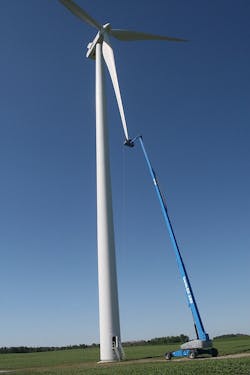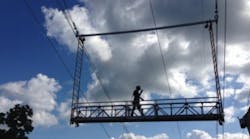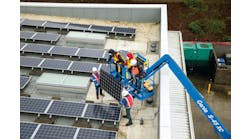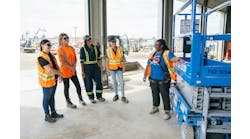Danish wind turbine manufacturer Vestas Wind Systems utilized four new self-propelled Genie SX-180 boomlifts to increase efficiency in turbine maintenance and repair. Vestas used the units to retrofit 50 Upper Michigan towers with lightning-deterrent tips. Despite wet and cold weather, site supervisor Tim Matthews used the units to complete the job ahead of schedule.
“As a company, we’re among the leading wind turbine manufacturers in North America in terms of installed capacity,” said Matthews. “Our company is based in Denmark, but here in the U.S. we have sales offices in Portland, Ore., and manufacturing facilities at several locations in Colorado. Part of an after-sale service we offer is a maintenance contract with the companies that purchase our turbines.”
Vestas was called upon to install lighting-deterrent copper tips on the blades of each of the 50 turbines operating at the 90 MW-capacity wind farm Michigan Wind 2. Even at their lowest position, the turbine tips are higher than 155 feet off the ground, making access to the work area challenging.
Matthews needed a better means to access the blade tips. “The timing couldn’t have been better for us,” he said. “We had already been looking into using a Genie Super Boom on a previous project, but things didn’t quite pan out. The fact that these were coming available just as we were starting up was a good sign. Vestas is constantly looking for more efficient and cost-effective ways to do the job out here and these lifts, by nature of their much shorter setup time, looked to be a great solution for us.”
Matthews liked the fact that the new boomlifts offered 180 feet of reach, about 25 more feel than actually needed to do the retrofits.
“It’s nice to have that additional reach in reserve,” he said. “It allows us room to maneuver the boom into the best possible position, rather than being constrained by a boom whose reach has been maxed out. With an extra 25 feet of reach, additional opportunities like looking further up each blade for lightning damage or leading edge erosion become possible. That’s a nice luxury to have.”
Vestas’ procedure for retrofitting the blades with the lightning deflectors was fairly simple. Using the controllers in the towers, workers moved the rotor into the appropriate position with the target blade pointing downward. Then they set up a service brake that locked the rotor in place. Looking pins ensured that the blade and rotor remained stationery.
“There is a pretty intense lock-out procedure in place anytime we are accessing these blades,” Matthews said. “Once we have it in position and secured though, we simply boom up to the blade, remove the existing lightning receptor and, using a combination of bolts and an adhesive, affix the new copper tip to the blade.”
Matthews also liked the SX-180’s 8-foot by 3-foot work platform and the width that expands from 8 feet, two inches to 16 feet, 6 inches, as well as the 10-foot jib that rotates 60 degrees horizontally and 135 feet vertically.
“My crews report that having that kind of movement on the jib has been a real asset on this project,” added Matthews. “They’ve been able to access specific work areas much easier than in the past. As a result, production rates have been very favorable for us: depending on weather, we were generally completing three blades in two days.”
Vestas Wind Systems rented the units from Titan Equipment in Midland, Mich.








